StarBright Blue Dyes

- On This Page
- SBB Dye Range
- SBB580
- SBB615
- SBB675
- SBB700
- SBB765
- SBB810
- All StarBright Blue Antibodies
Excitable by the 488 nm laser, StarBright™ Blue (SBB) Dyes are perfect to replace existing dyes in your flow cytometry panels and expand your capabilities across the blue laser.
Designed to be bright enough to resolve most populations, with reduced excitation by the 561 and 640 nm lasers, StarBright Blue Dyes should be your first choice in panel design.
SBB Dye Range
StarBright Dye |
Max Ex, nm |
Max Em, nm |
Brightness (1-5) |
5-Laser ZE5 Cell Analyzer Optimal Filter |
3/4-Laser ZE5 Cell Analyzer Optimal Filter |
Comparison Dye |
Launch Date |
Flier |
|---|---|---|---|---|---|---|---|---|
|
475 |
582 |
4 |
593/52 |
583/30 |
- |
Available now |
||
|
475 |
612 |
4 |
593/52 |
615/24 |
- |
Available now |
||
|
476 |
675 |
5 |
692/80 |
692/80 |
PerCP |
Available now |
||
|
473 |
703 |
5 |
692/80 |
692/80 |
PerCP-Cy5.5, BB700, PerCP-eFluor710 |
Available now |
||
|
476 |
764 |
4 |
750LP |
750LP |
- |
Available now |
||
|
477 |
802 |
4 |
750LP |
750LP |
- |
Available now |
Abbreviations: Axxx, Alexa Fluor; BB, Brilliant Blue; Cy, cyanine; FITC, fluorescein isothiocyanate; PerCP, peridinin chlorophyll protein.
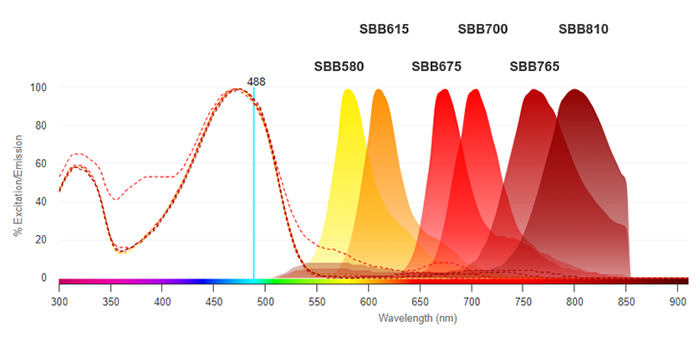
Fig. 1. Excitation and emission spectra of StarBright Blue Dyes.
StarBright Blue Dyes in Focus
Below we provide more in-depth information about each individual dye, including usage information, conventional spectra visuals (wavelength and channel), and brightness comparison data. Simply click on the “+” to reveal your desired information.
StarBright Blue 580 (SBB580) Dye
SBB580 Dye is a bright, 488 nm laser excitable dye with a unique narrow excitation and emission profile and is suitable for conventional and full spectrum flow cytometry (Figure 2).
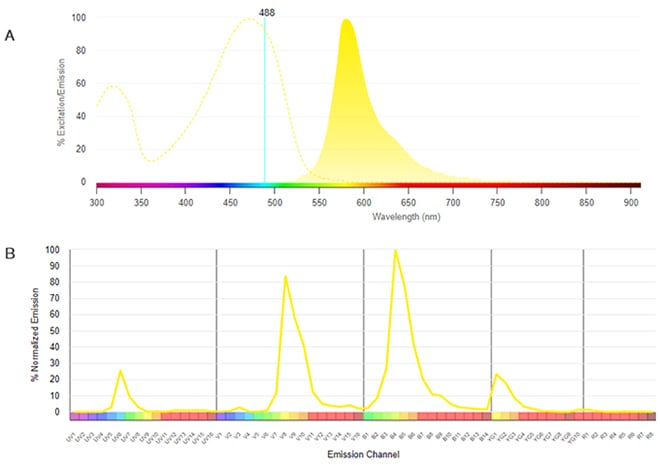
Fig. 2. SBB580. A, Conventional spectra. Excitation by the blue laser (dotted line) with emission shown in the shaded histogram. B, Normalized dye signature. Full emission spectrum showing the emission at all wavelengths. Data were collected on a 5-L Cytek Aurora Flow Cytometry System using SpectroFlo Software.
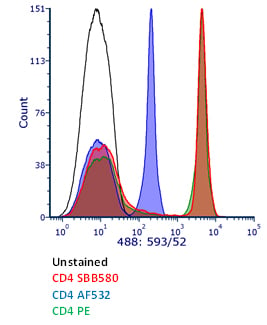
Fig. 3. Brightness comparison. Human peripheral blood was stained with CD4 SBB580 (MCA1267SBB580) or CD4 AF532 and CD4 PE. SBB580 is over ten times as bright as AF532 and of similar brightness to PE.
It is brighter than other 488 nm laser excitable dyes such as AF532, and is as bright as PE when excited by the 488 nm laser (Figure 3).
It has the added benefit of having reduced excitation by the 561 nm laser compared with PE.
SBB580 and PE are compatible in a panel when using both the 488 and 561 nm lasers to excite each respective dye.
StarBright Blue 615 (SBB615) Dye
SBB615 Dye is a bright, 488 nm laser excitable dye with a unique, narrow excitation and emission profile and is suitable for conventional and full spectrum flow cytometry (Figure 4).
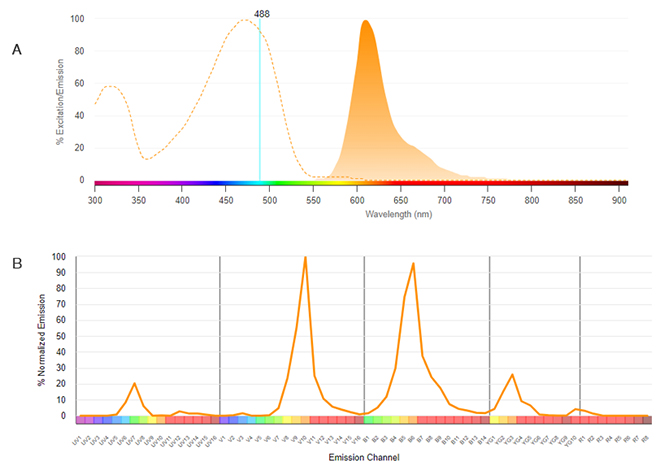
Fig. 4. SBB615. A, Conventional spectra. Excitation by the blue laser (dotted line) with emission shown in the shaded histogram. B, Normalized dye signature. Full emission spectrum showing the emission at all wavelengths. Data were collected on a 5-L Cytek Aurora Flow Cytometry System using SpectroFlo Software.
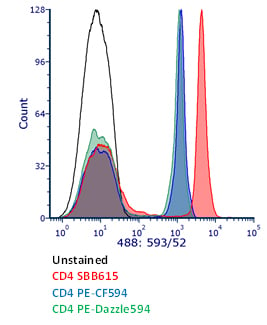
Fig. 5. Brightness comparison. Human peripheral blood was stained with CD4 SBB615 (MCA1267SBB615), CD4 PE-CF594, or CD4 PE-Dazzle-594. SBB615 is more than twice as bright as PE-CF594 and PE-Dazzle594.
On some spectral analyzers SBB615 will have a strong 405 nm excitation resulting in some spread with 405 nm excitable dyes with similar emission wavelengths such as SBV610 and BV605.
SBB615 is brighter than PE-CF594 and PE-Dazzle594 when excited by the 488 nm and is not excited to the same degree by the 561 nm laser (Figure 5).
As it is not a traditional tandem dye, SBB615 does not have issues around tandem breakdown and changes to staining over time. SBB615 provides more choice and flexibility when building multicolor panels incorporating the 488 nm laser.
StarBright Blue 675 (SBB675) Dye
SBB675 Dye is a very bright, 488 nm laser excitable dye with a unique narrow excitation and emission profile and is suitable for conventional and full spectrum flow cytometry (Figure 6).
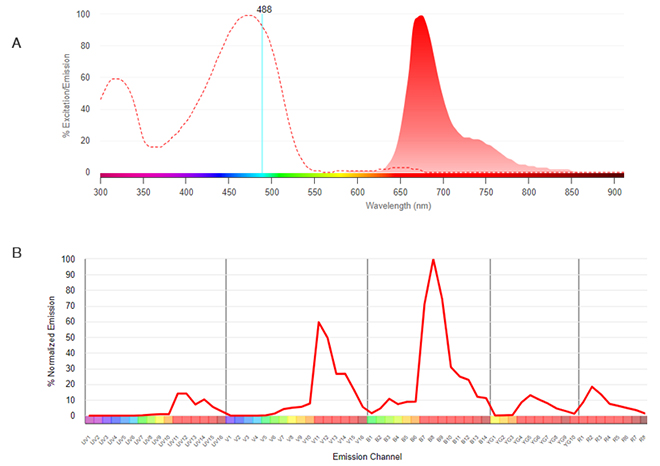
Fig. 6. SBB675. A, Conventional spectra. Excitation by the blue laser (dotted line) with emission shown in the shaded histogram. B, Normalized dye signature. Full emission spectrum showing the emission at all wavelengths. Data were collected on a 5-L Cytek Aurora Flow Cytometry System using SpectroFlo Software.
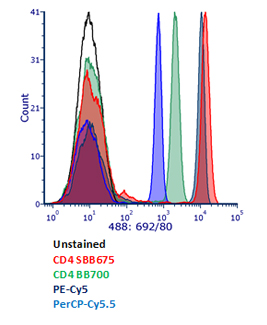
Fig. 7. Brightness comparison. Human peripheral blood was stained with CD4 SBB675 (MCA1267SBB675), CD4 PerCP-Cy5.5, CD4 BB700, and CD4 PE-Cy5. SBB675 is ten times as bright as PerCP-Cy5.5 and five times as bright as BB700.
It is brighter than other 488 nm laser excitable dyes such as PerCP-Cy5.5 (and PerCP) and BB700 and PE-Cy5 when excited by the 488 nm laser (Figure 7).
As it is not a traditional tandem dye, SBB675 does not have issues around tandem breakdown and changes to staining over time.
It exhibits reduced excitation by the 561 nm laser compared to PE tandem dyes. SBB675 provides more choice and flexibility when building multicolor panels incorporating the 488 nm laser.
StarBright Blue 700 (SBB700) Dye
SBB700 Dye is the perfect replacement for PerCP, PerCP-based-tandem dyes, such as PerCP-Cy5.5, and Brilliant Blue 700 (BB700) in your flow cytometry experiments. It is as bright as BB700 and brighter than PerCP-Cy5.5 (Figure 9). Furthermore, SBB700 has a unique spectral profile allowing it to be combined with PerCP-Cy5.5 or BB700 in full-spectrum flow cytometry (Figure 10).
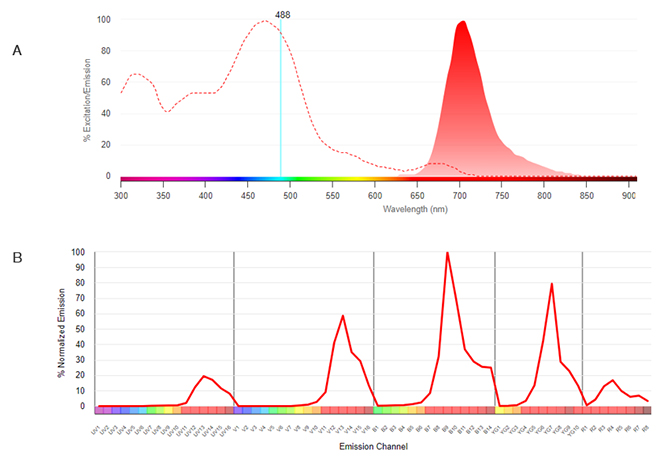
Fig. 8. SBB700. A, Conventional spectra. Excitation by the blue laser (dotted line) with emission shown in the shaded histogram. B, Normalized dye signature. Full emission spectrum showing the emission at all wavelengths. Data were collected on a 5-L Cytek Aurora Flow Cytometry System using SpectroFlo Software.
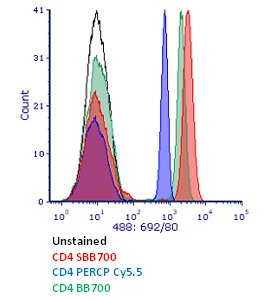
Fig. 9. Brightness comparison. Human peripheral blood was stained with CD4 SBB700 (MCA1267SBB700) or CD4 PerCP-Cy5.5 and CD4 BB700. SBB700 is four times as bright as PerCP-Cy5.5 and one and a half times as bright as BB700.
In addition to the increased brightness, SBB700 has reduced excitation by the 640 nm laser, and therefore less compensation is required when combining with A647 and A700 in multicolor panels compared with PerCP-Cy5.5 and BB700.
Relatively high levels of compensation may be required when combining SBB700 with StarBright Violet 710 (SBV710) Dye, leading to spreading with values of ~2.
While this is not a major issue, we would recommend using mutually exclusive markers for this combination in conventional flow. This combination has a similarity score of 0.64 in spectral flow cytometry (determined using SpectroFlo Software) and is, therefore an excellent combination to use.
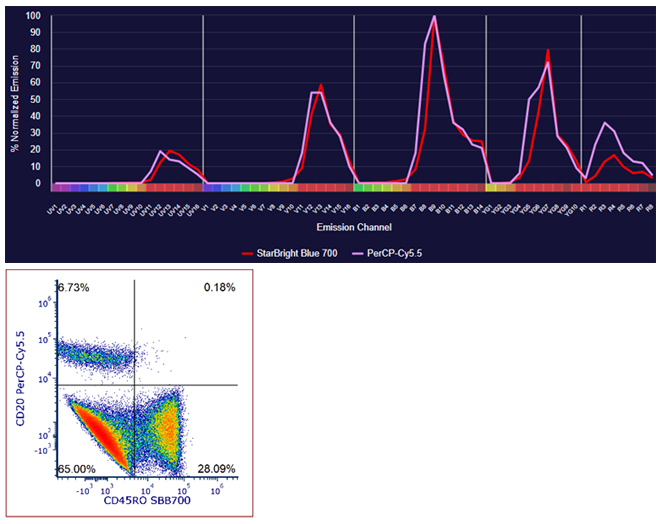
Fig. 10. SBB700 in full spectrum flow cytometry. A, the full emission spectrum of SBB700 and PerCP-Cy5.5 showing the emission at all wavelengths. B, human peripheral blood monocytes were stained for CD20 PerCP-Cy5.5 and CD45RO SBB700 (MCA461SBB700) to reveal B cell and T cell memory populations. Data were collected on the Cytek Aurora Flow Cytometry System using SpectroFlo Software.
StarBright Blue 765 (SBB765) Dye
SBB765 Dye is a bright, 488 nm laser excitable dye with a unique narrow excitation and emission profile and is suitable for conventional and full spectrum flow cytometry.
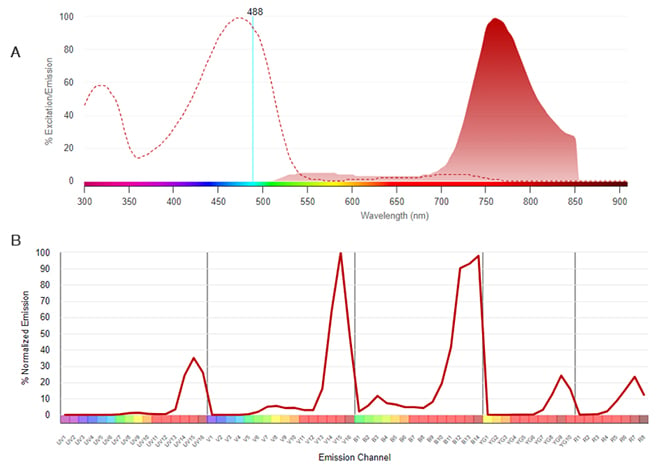
Fig. 11. SBB765. A, Conventional spectra. Excitation by the blue laser (dotted line) with emission shown in the shaded histogram. B, Normalized dye signature. Full emission spectrum showing the emission at all wavelengths. Data were collected on a 5-L Cytek Aurora Flow Cytometry System using SpectroFlo Software.
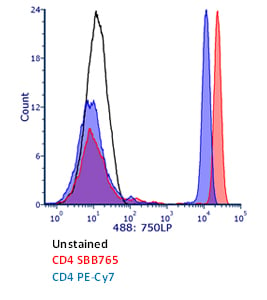
Fig. 12. Brightness comparison. Human peripheral blood was stained with CD4 SBB765 (MCA1267SBB765) or CD4 PE-Cy7. SBB765 is almost twice as bright as PE-Cy7 when excited by the 488 nm laser.
On some spectral analyzers SBB765 will have a strong 405 nm excitation resulting in some spread with 405 nm excitable dyes with similar emission wavelengths such as SBV760 and BV750 (Figure 11).
It is brighter than PE-Cy7 when excited by the 488 nm laser (Figure 12). As it is not a traditional tandem dye, SBB765 does not have issues around tandem breakdown and changes to staining over time and exhibits reduced excitation by the 561 nm laser compared to PE tandem dyes.
SBB765 provides more choice and flexibility when building multicolor panels incorporating the 488 nm laser.
StarBright Blue 810 (SBB810) Dye
SBB810 Dye is a bright, 488 nm laser excitable dye with a unique narrow excitation and emission profile and is suitable for conventional and full spectrum flow cytometry (Figure 13).
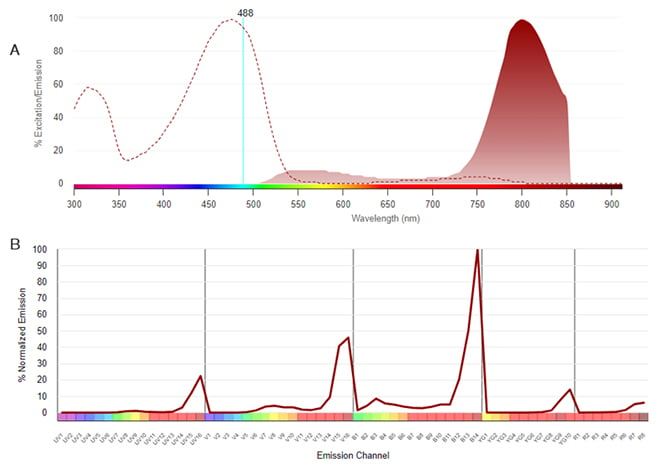
Fig. 13. SBB810. A, Conventional spectra. Excitation by the blue laser (dotted line) with emission shown in the shaded histogram. B, Normalized dye signature. Full emission spectrum showing the emission at all wavelengths. Data were collected on a 5-L Cytek Aurora Flow Cytometry System using SpectroFlo Software.
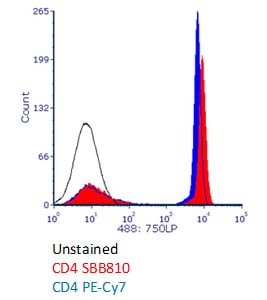
Fig. 14. Brightness comparison. Human peripheral blood was stained with CD4 SBB810 (MCA1267SBB810) or CD4 PE-Cy7. SBB810 is brighter than PE-Cy7 when excited by the 488 nm laser.
On some spectral analyzers it may have its maximal emission in the same channel (B14) as SBB765, but with a similarity score of 0.85 they can still be used together. Despite being dimmer than SBB765, the reduced excitation by the 405 nm laser may make this more suitable in some panels.
It is brighter than PE-Cy7 when excited by the 488 nm laser (Figure 14). As it is not a traditional tandem dye, SBB810 does not have issues around tandem breakdown and changes to staining over time and exhibits reduced excitation by the 561 nm laser compared to PE tandem dyes.
SBB810 provides more choice and flexibility when building multicolor panels incorporating the 488 nm laser.
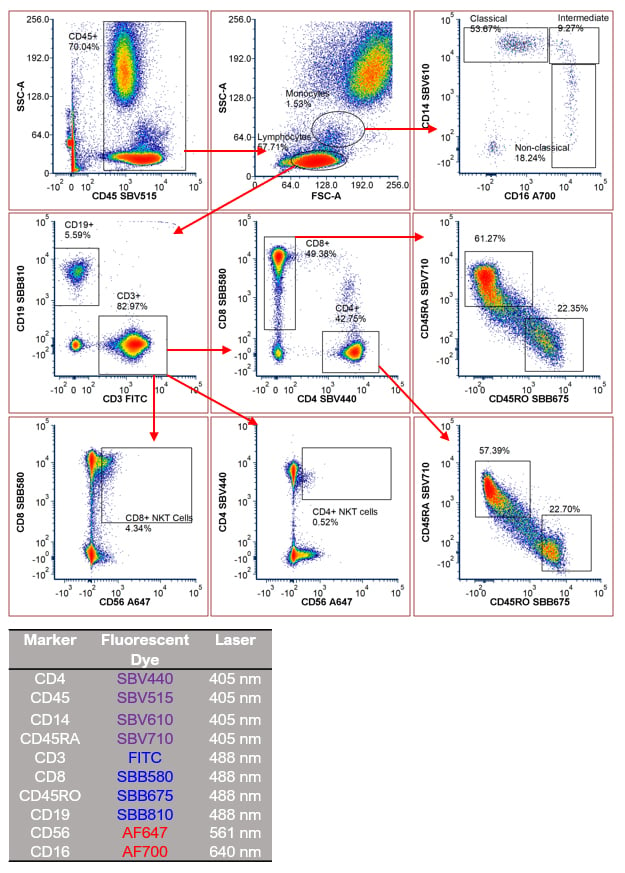
Fig. 15. Ten-color panel containing SBB and SBV Dyes. Human peripheral blood was stained for CD45 (MCA87SBV515), CD56 (MCA2693A647), CD3 (MCA463F), CD19 (MCA1940SBB810), CD4 (MCA1267SBV440), CD8 (MCA1226SBB580), to identify NK cells, B and T lymphocytes, and T helper, T cytotoxic cells. Classical, intermediate, and nonclassical monocytes were identified using CD14 (MCA1568SBV610) and CD16 (MCA2537A700). Further characterization of the T helper cells was obtained from CD45RA (MCA88SBV710) and CD45RO (MCA461SBB675) to identify naïve and memory cells. Data generated on the ZE5 Cell Analyzer.
StarBright Blue Antibodies
| Description | Target | Format | Clone | Applications | Citations | Code |
|---|
Associated Reading
For more information on how these products can improve the effectiveness of your flow cytometry experiments, please take a look at our StarBright Dyes page.
Useful information about fluorescent dyes and immunophenotyping can be found in our flow cytometry explained knowledge hub. Alternatively, feel free to explore the associated resource links below, for more in-depth information about each cited topic. If you are interested in learning the fundamentals of this application, please view our Flow Cytometry Basics Guide.




